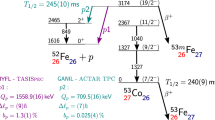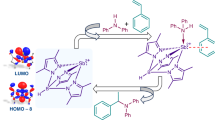Abstract
WE have shown that bromo-ethyl benzyl bromide condenses with phenyl-dichloro-arsine in the presence of sodium to give 2-phenyl -1: 2: 3: 4-tetrahydro-iso-arsinoline1, which readily combines with p-chlorophenacyl bromide to give 2-phenyl-2-p-chlorophenacyl-1: 2: 3: 4- tetrahydro - iso - arsinolinium bromide (I). This salt contains an asymmetric arsenic atom, and we were able to resolve it into optically active forms, the corresponding dextro and laevo isoarsinolinium picrates having [M]D + 457° and -450° respectively in chloroform solution.
This is a preview of subscription content, access via your institution
Access options
Subscribe to this journal
Receive 51 print issues and online access
$199.00 per year
only $3.90 per issue
Buy this article
- Purchase on SpringerLink
- Instant access to full article PDF
Prices may be subject to local taxes which are calculated during checkout
Similar content being viewed by others
References
NATURE, 151, 474 (1943).
J. Chem. Soc., 81, 1552 (1902).
Author information
Authors and Affiliations
Rights and permissions
About this article
Cite this article
MANN, F., HOLLIMAN, F. An Optically Active Selenonium Salt. Nature 152, 749–750 (1943). https://doi.org/10.1038/152749a0
Issue date:
DOI: https://doi.org/10.1038/152749a0



